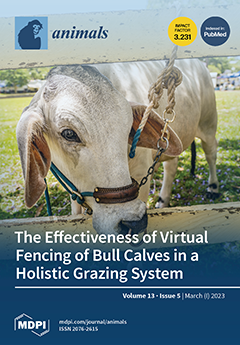The purpose of this experiment was to examine the effects of MFL supplementation on feed intake, nutrient digestibility, milk yield, and milk composition in early lactating dairy cows. Twelve, Thai crossbred Holstein Friesian cows in early lactation, 500 ± 30 kg of body weight (BW), were randomly assigned according to a completely randomized design (CRD). MFL supplementation levels of 0, 100, 200, and 300 mL/d were used as treatments. Experimental animals were fed a total mixed ration (TMR) with a roughage to concentrate ratio (R:C ratio) of 40:60, which contains 12% crude protein (CP) and 70% total digestible nutrient (TDN). Rice straw was a roughage source. MFL supplementation levels had no effect (
p > 0.05) on body weight change and dry matter intake (DMI) expressed as %BW, whereas DMI expressed as metabolic body weight (BW
0.75) was linearly (
p < 0.05) increased, with the highest at 200 mL/d in the YFL supplementation group (147.5 g/kg BW
0.75), whereas feed intake of organic matter (OM), CP, ether extract (EE), neutral detergent fiber (NDF) and acid detergent fiber (ADF) did not significant (
p > 0.05) difference among treatments. Related to apparent digestibility, MFL levels did not affect (
p > 0.05) on DM, OM, and EE digestibility, while apparent digestibility of CP, NDF, and ADF were linearly increased (
p < 0.05) when increasing MFL supplementation levels, and the highest (
p < 0.05) were the 200 and 300 mL/d FML supplemented groups. BUN at 0 h post feeding did not show a significant difference (
p > 0.05) between treatments, while at 4 h after feeding, BUN was linearly (
p < 0.05) increased from 0, 100, 200, and 300 (mL/day) MFL supplementation, the values were 12.9, 13.1, 19.7, and 18.4 mg/dL, respectively and the highest was 200 mL/head/day for the MFL supplemented group. MFL supplementation did not affect (
p > 0.05) milk fat, lactose, solid not fat (SNF), and specific gravity of milk, while MFL supplementation at 200 mL/day caused a linear increase (
p < 0.01) in BUN, MUN, milk yield, milk protein, total solids (TS) and 3.5% FCM when supplement levels were increased. In conclusion, MFL supplementation in early lactating dairy cows could improve feed intake, nutrient digestibility, milk yield, and milk composition.
Full article






